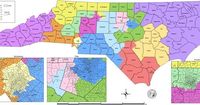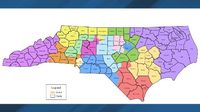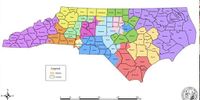The North Carolina State Senate set off a political firestorm on October 20, 2025, as it gave preliminary approval to a new Congressional map that would tilt the state’s delegation even further toward the Republican Party. In a 25-20 vote that fell strictly along party lines, lawmakers advanced a mid-decade redistricting plan that could reshape the balance of power in Washington—and reignite long-standing debates about race, representation, and democracy in the Tar Heel State.
At the heart of the controversy is North Carolina’s 1st Congressional District, a region with deep historical significance and a legacy of Black political representation dating back to the early 1990s. The new map, pushed rapidly through the Senate Elections Committee earlier that same day, would shift several counties between the 1st and 3rd districts, making the 1st far more favorable to Republicans. According to WTVD, Beaufort, Carteret, Craven, Dare, Hyde, and Pamlico counties would move from District 3 to District 1, while Greene, Lenoir, Wayne, and Wilson counties would shift in the opposite direction.
Senator Ralph Hise, a Mitchell County Republican who presented the plan, was blunt about the motivation behind the redraw. “The motivation behind this redraw is simple and singular: draw a new map that will bring an additional Republican seat to the Congressional delegation,” Hise declared during the committee hearing, as reported by WTVD and NC Newsline. He emphasized that with Republicans holding a “razor-thin margin” in the U.S. House, the stakes could not be higher. “If Democrats flip four seats in the upcoming midterm elections, they will take control of the House and torpedo President Trump’s agenda,” Hise said.
The updated map would, in effect, transform District 1 from a highly competitive seat—where President Trump earned 51% of the vote in 2024—to one where he would have secured 55%. District 3, meanwhile, would remain safely in Republican hands. The new configuration is expected to shift North Carolina’s Congressional delegation from its current makeup of 10 Republicans and 4 Democrats to a commanding 11-3 Republican advantage, according to both WTVD and NC Newsline.
Republican leaders have not been shy about the political calculus at play. Senate Leader Phil Berger, R-Rockingham, invoked the specter of national Democratic redistricting efforts, telling colleagues, “North Carolina is fighting fire with fire. If Gavin Newsom and his Democrat cronies want to try and take control of Congress to force their liberal agenda on the American people, then we’re going to respond in kind.” Berger also noted, “Donald Trump, the president, asked that legislatures look at their maps, determine whether or not it’s possible to add additional individuals that would support the agenda that the president has advanced.”
President Trump himself weighed in on social media, publicly applauding North Carolina Republicans for the new map and stating it would give the state “the opportunity to elect another MAGA Republican next year.” He added that he was “watching, and strongly supporting” the redistricting effort, as NC Newsline reported.
Democrats, on the other hand, have condemned the plan as a cynical and racially motivated power grab. Governor Josh Stein, a Democrat, called the redistricting “a cynical power grab” at a news conference on October 20, 2025. “The Republican legislature is abusing its power to take away yours,” Stein said, urging lawmakers to focus on issues like mental health and Medicaid instead. Senator Terence Everitt, D-Wake, went even further during floor debate, declaring, “History will remember when fascism came to North Carolina. You could not wait to get on your knees.”
The public response was equally fierce. During the committee meeting and subsequent Senate debate, protesters filled the gallery, chanting “Racist maps make racist reps” and holding up signs that read “cheaters.” According to NC Newsline, several were ejected from the chamber, with one woman shouting “shameful” as she was escorted out. Robert Yhl of Raleigh, speaking during public comment, called the plan “a tool of voter suppression,” adding, “It makes more sense to me for the legislature to do what their people elected it to do, and that is to conduct business for the people and not conduct activities ordered by a convicted felon.”
Much of the criticism has centered on the impact the new map would have on Black voters in the 1st District. Since 1992, this district has consistently elected Black representatives, beginning with Eva Clayton—the first Black member of Congress from North Carolina since Reconstruction. The district, anchored in the state’s historic Black Belt, includes counties with majority Black populations and a legacy of struggle for civil rights and political representation. Under the new map, several of these counties would be moved out of District 1, raising fears of diluted Black voting power and lost representation.
Senator Kandie Smith, D-Pitt, warned that the plan would “undermine the Black electorate” and “silence rural Black voices.” Senator Gladys Robinson, D-Guilford, did not mince words, calling the map “blatant racism” and predicting, “Black people will not have representation in terms of ability to elect a person that they want. Don Davis will be gone.” Senate Minority Leader Sydney Batch, D-Wake, pressed Hise during floor debate about whether racial data had been used to draw the map. Hise insisted that it had not.
Former representatives Eva Clayton and G.K. Butterfield issued a joint statement through Common Cause NC, saying, “The proposed congressional map would silence communities that have long been the backbone of northeastern North Carolina, fracturing counties and towns that share common bonds of history, economy and hope. This is not merely a political act—it is a moral regression.” They also criticized the lack of public input, stating, “We are offended that the people … have not been given ample opportunity to provide their input. This is not how democracy is supposed to work.”
Democrats have also raised the specter of legal challenges, pointing out that the current configuration of the 1st District is already the subject of a federal lawsuit over the dilution of Black voting power. Hise, for his part, expressed confidence that the new plan would withstand court scrutiny. “We will defend these maps, and I am confident they will be held by the courts,” he said.
North Carolina’s redistricting saga is hardly unique; it is just the latest chapter in a nationwide battle over political boundaries, with states like Texas and California also redrawing lines in response to shifting political winds and national party priorities. But the speed and explicit partisanship of the current effort in Raleigh have left many residents anxious about the future of their representation—and the health of democracy itself.
The final Senate vote on the proposed map is scheduled for October 21, 2025, with the House of Representatives expected to take up the measure soon after. As the debate rages on, figures like Eva Clayton and G.K. Butterfield are preparing to make their voices heard once again, rallying supporters to defend what they see as the core principles of justice, equality, and fair representation. “If the citizens don’t have the will to stand up, we’re lost,” Clayton said. “I pray to God that we have the strength to stand up for democracy, stand up for justice, stand up for equality.”
This battle over lines on a map is about far more than geography—it’s about who gets to decide the future of North Carolina, and whose voices will count when the next chapter of its history is written.



